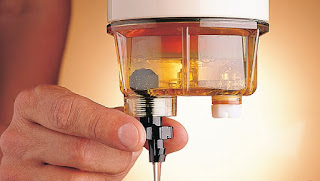Water In A Diesel Fuel
Without a doubt, the number one particular reported problem with diesel fuel is water, which eventually results in microbial growth and engine breakdown.This water has the possible to cause numerous problems - freezing in cold climate, delivering a growth medium for bacteria, accelerating the aging from the fuel to produce gums and shellacs, and causing injector tips to malfunction. See also Water In Gas Tank Symptoms
Diesel engines produce water when hot fuel in the injectors is returned to the fuel tank; this produces water from condensation, which settles beneath the fuel. Injectors produce a lot more heat than they did 20 years ago due to the fact the performance specifications for the engines are greater than ever ahead of. These injectors have to be kept cool or else they're going to destroy themselves.
Diesel engine systems circulate fuel from the fuel tank across the injectors to dissipate a few of the heat and kept the injectors cooler. The hot “return fuel” is then cycled back to the fuel tank. When the hot return fuel is returned to the tank, the improve temperature causes a higher amount of water from the air inside the tank to condense in to the fuel. This causes a steady build-up of water in the bottom from the fuel tank over a period of time.
Water is also developed from diesel fuel storage because of vented storage tanks and humid air. All storage tanks are vented towards the outdoors air, resulting in continual circulation of humid air from the outdoors. Anytime there’s a 7-degree temperature decrease, condensation occurs. Specifically at evening, the air temperature cools, and water vapor condenses into the fuel and sinks for the bottom (due to the fact water is heavier than fuel).
How to Get Water Out of Diesel Fuel
Water in diesel fuel is actually a serious issue that must be addressed right away. The fuel pump in a diesel engine operates at a very high pressure and with really precise tolerances. Any contaminant, which includes water, may cause pricey damage. Water within the fuel can also promote the growth of bacteria and fungi. These micro-organisms produce a slime that moves via the fuel system, clogging filters and fouling fuel injectors. Additionally they produce acids that could corrode metal surfaces.Left alone, water will settle for the bottom if it's mixed with diesel fuel.
- Determine whether or not there is water inside the diesel fuel. Extract a small amount of the suspect fuel using a hand-operated bilge pump. Place the fuel inside a clear, clean glass container and permit it to sit within a dark spot for 24 hours. Diesel is lighter than water so if there is water within the fuel, it is going to settle towards the bottom in the jar. Look to view if there is a thin black line between the water and also the diesel. If there is certainly, microorganisms have began to develop, which means you will need to add a biocide. It will be less complicated to filter the water in the diesel fuel if it has been allowed to settle.
- Let the fuel settle. Attempt not to move the container, ideally for any day. This applies no matter whether it really is the fuel tank on a car or boat or possibly a hand-carried fuel can. Water reduces the lubricating effectiveness of diesel fuel.
- Bleed the water from the fuel filter if one particular is in location. Storage containers and boat fuel tanks made for diesel ought to have fuel-water separators with petcocks at the bottom. Some are see-through so you can effortlessly inform when all of the water has been drained. You might be better off draining a lot of than too little. Water can get into a fuel tank even though it really is becoming filled, or basically from condensation.
- If the fuel is in a tank that doesn't have a fuel filter, pump the water out from the bottom. Match the extension hose towards the bilge pump, making sure that you have added adequate hose to attain the bottom from the tank. Pump all the water you can from the bottom on the tank.
- When the diesel is in a hand-carried fuel can, pour it slowly via the baja filter into a second container.
- Add biocide. Industrial biocides for diesel fuel are available at auto components stores, truck stops and many boating stores and marinas. Comply with the manufacturer’s directions when adding biocide towards the fuel.
See also
Tags
Cars
